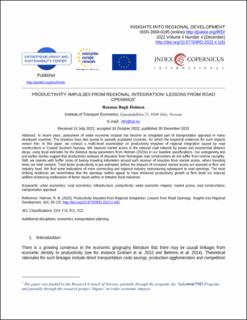| dc.contributor.author | Holmen, Rasmus Bøgh | |
| dc.coverage.spatial | Oslo, Norway | en_US |
| dc.date.accessioned | 2023-06-13T11:14:17Z | |
| dc.date.available | 2023-06-13T11:14:17Z | |
| dc.date.created | 2023-01-03T10:20:43Z | |
| dc.date.issued | 2022-11-07 | |
| dc.identifier.citation | Insights into Regional Development. 2022, 4 (4), 83-125. | en_US |
| dc.identifier.issn | 2669-0195 | |
| dc.identifier.uri | https://hdl.handle.net/11250/3071108 | |
| dc.description | INSIGHTS INTO REGIONAL DEVELOPMENT is an open-access journal, which means that the journal and individual articles are available to readers without any restrictions and free of charge. Authors retain the copyright without restrictions. Authors can deposit all versions of their work (submitted, accepted or published) in an institutional or other repository of their choice without embargo. | en_US |
| dc.description.abstract | In recent years, assessment of wider economic impacts has become an integrated part of transportation appraisal in many developed countries. The practices have also spread to sparsely populated countries, for which the empirical evidences for such impacts remain thin. In this paper, we conduct a multi-level examination on productivity impulses of regional integration caused by road constructions in Coastal Southern Norway. We measure market access in the national road network by power and exponential distance decay, using local estimates for the distance decay parameters from Holmen (2022a) in our baseline specifications. Our endogeneity test and earlier studies suggest that productivity analyses of impulses from Norwegian road constructions do not suffer from reverse causality. Still, we operate with buffer zones of twenty traveling kilometers around each receiver of impulses from market access, where traveling times are held constant. Total factor productivity is pre-estimated, before the impacts of increased market access are assessed at firm and industry level. We find some indications of more commuting and regional industry restructuring subsequent to road openings. The most striking evidences are nevertheless that the openings neither appear to have enhanced productivity growth at firm level nor induced welfare-enhancing reallocation of factor inputs within or between local industries. | en_US |
| dc.description.abstract | Productivity impulses from regional integration: lessons from road openings | en_US |
| dc.language.iso | eng | en_US |
| dc.publisher | Entrepreneurship and Sustainability Center | en_US |
| dc.title | Productivity impulses from regional integration: lessons from road openings | en_US |
| dc.title.alternative | Productivity impulses from regional integration: lessons from road openings | en_US |
| dc.type | Journal article | en_US |
| dc.type | Peer reviewed | en_US |
| dc.rights.holder | © 2022 Author | en_US |
| dc.description.version | publishedVersion | en_US |
| cristin.ispublished | true | |
| cristin.fulltext | original | |
| cristin.qualitycode | 1 | |
| dc.identifier.doi | 10.9770/IRD.2022.4.4(6) | |
| dc.identifier.cristin | 2099402 | |
| dc.source.journal | Insights into Regional Development | en_US |
| dc.source.volume | 4 | en_US |
| dc.source.issue | 4 | en_US |
| dc.source.pagenumber | 83-125 | en_US |
| dc.relation.project | Norges forskningsråd: 209745 | en_US |
| dc.relation.project | Norges forskningsråd: 267697 | en_US |
